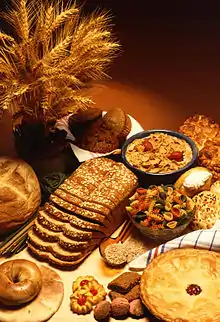Red Fife wheat
Red Fife is a wheat variety that was the baking and milling industries' standard of wheat in Canada from 1860 to 1900. The wheat was originally sent to Peterborough, Ontario farmer David Fife in 1840, from whom it took its name. It is impossible to verify where the wheat originated as grain has moved around the world for many centuries.
It is the oldest variety of wheat in Canada and it was the most popular type of wheat grown in Canada in 1860s, but has nearly disappeared by 2019.[1]
There are no native varieties of wheat in Canada.
In 1987 Sharon Rempel planted a "Living Museum of Wheat" at The Grist Mill at Keremeos, an 1880s living history site in Keremeos, British Columbia, Canada. Heritage varieties included Red Fife, Ladoga, Bishop, Preston, Hard Red Calcutta, Marquis and Stanley. [2]
Jennifer Scott and organic farmers in the Maritimes began to grow heritage wheats in the mid-1990s. In 1999, Onoway, Alberta farmer Kerry Smith began growing Red Fife and other historic varieties. In 2000, 2001 and 2002, the Alberta Organic Association’s Walter Walchuk, along with Rempel, co-hosted organic heritage wheat field trials throughout Alberta.
Red Fife was nominated to the Slow Food Ark of Taste in 2003 by Mara Jernigan and Sinclair Phillip of Slow Food Canada. This was the first heritage wheat put on the Ark.
There are many artisan bakeries using Red Fife wheat in their products.
References
- Acken, D. L.; Lycopolus, Emily (2019-09-24). Cedar and Salt: Vancouver Island Recipes from Forest, Farm, Field, and Sea. TouchWood Editions. p. 33. ISBN 978-1-77151-295-4.
- Rempel, Sharon. “Red Fife Wheat,” The Canadian Encyclopedia (2009), doi: https://www.thecanadianencyclopedia.ca/en/article/red-fife-wheat/
